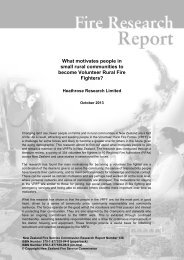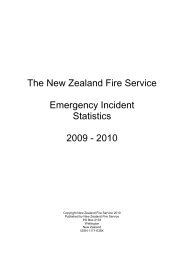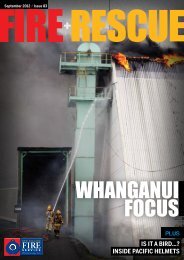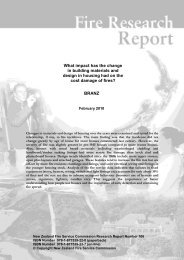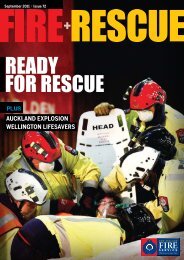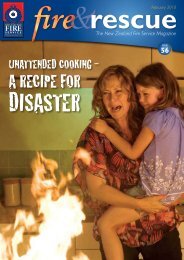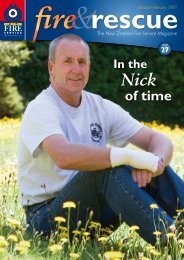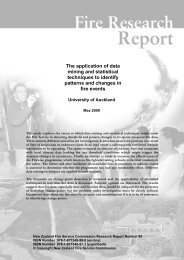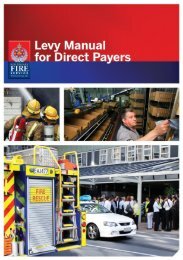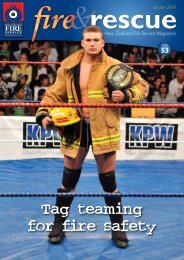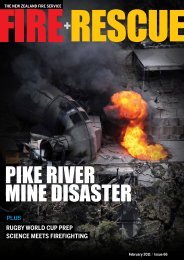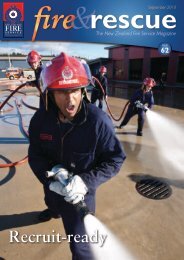Download - New Zealand Fire Service
Download - New Zealand Fire Service
Download - New Zealand Fire Service
You also want an ePaper? Increase the reach of your titles
YUMPU automatically turns print PDFs into web optimized ePapers that Google loves.
July 2010<br />
The <strong>New</strong> <strong>Zealand</strong> <strong>Fire</strong> <strong>Service</strong> Magazine<br />
History repeats<br />
ISSUE<br />
60
July 2010<br />
Issue No. 60<br />
<strong>Fire</strong> & Rescue is the flagship<br />
publication of the <strong>New</strong> <strong>Zealand</strong><br />
<strong>Fire</strong> <strong>Service</strong>.<br />
It is produced by Media,<br />
Promotions and Communications,<br />
National Headquarters,<br />
Level 9, 80 The Terrace, Wellington.<br />
Front cover: An aerial pours water on the fire<br />
at Southdown Freezing Works, photo NZPA.<br />
Back cover: One of the more than 400<br />
contestants races up the Sky Tower stairs.<br />
Contributions to <strong>Fire</strong> & Rescue<br />
We welcome ideas for articles, news<br />
and events that would be of interest to<br />
other <strong>Fire</strong> <strong>Service</strong> staff and volunteers.<br />
Draft articles and photos (pictures<br />
need to be at least 1MB) can be<br />
emailed to fire.rescue@fire.org.nz or<br />
contact the editor Karlum Lattimore<br />
on 04 496 3702.<br />
Post written material and photos,<br />
or photo CDs to:<br />
<strong>Fire</strong> & Rescue magazine,<br />
PO Box 2133, Wellington.<br />
(These will be returned on request.)<br />
<strong>Fire</strong> & Rescue is online at:<br />
www.fire.org.nz<br />
ISSN: 1176-6670<br />
All material in <strong>Fire</strong> & Rescue magazine is<br />
copyrighted and may not be reproduced<br />
without the permission of the editor.<br />
11<br />
4<br />
7 9<br />
Promotions Being smokefree saves lives ........................................................3<br />
It pays to advertise ...........................................................................3<br />
<strong>Fire</strong>-side Inside the fire – Southdown revisited .....................................4<br />
<strong>Fire</strong> Safety Re-packaging home fire safety ..................................................6<br />
Moving to long-life smoke alarms ............................................7<br />
<strong>Fire</strong> Insight CSI <strong>Fire</strong> Investigators ........................................................................8<br />
Burn to learn ........................................................................................9<br />
Marae safety taken seriously......................................................9<br />
Truck Update The Type 3 prototype – Back to the Future ...................10<br />
Number 100 now in service ....................................................11<br />
<strong>New</strong> Developments Testing time for gas suits ............................................................12<br />
<strong>New</strong> BA a step closer ..................................................................12<br />
Step-by-step guide to evacuation schemes .....................12<br />
People A couple of minutes with... John Sutherland ....................13<br />
Record-breaking stair climb ......................................................14<br />
Events 2010 Calendar ................................................................................15<br />
NZFI exam applications reminder .......................................15<br />
Martyn Baker’s newborn – Hamish ....................................15<br />
12<br />
14
Being smokefree<br />
saves lives<br />
The <strong>New</strong> <strong>Zealand</strong> <strong>Fire</strong> <strong>Service</strong> Magazine<br />
Promotions<br />
Each year, around 5,000 people die from smoking-related<br />
diseases while burning cigarettes cause 1,150 house fires.<br />
So Auckland <strong>Fire</strong> Region <strong>Fire</strong> Safety Officer, Gary Beer,<br />
joined forces with Harbour Health PHO to take the message<br />
to students at Massey University’s Albany campus for world<br />
Smokefree Day. Flint and Amber show the best way to snuff out a cigarette as part<br />
of a joint effort by the <strong>Fire</strong> <strong>Service</strong> and health agencies to<br />
demonstrate smoking is both a fire hazard<br />
and a health risk.<br />
It pays to advertise<br />
The new hard-hitting <strong>Fire</strong> <strong>Service</strong> television advertisements on the danger of<br />
unattended cooking have struck a real chord with the public.<br />
In our latest Communication Effectiveness<br />
survey almost everyone who<br />
saw the advertisement showing a<br />
fatal kitchen fire remembered it and<br />
got the message. It has been one of<br />
the <strong>Fire</strong> <strong>Service</strong>’s most effective<br />
advertisements.<br />
The 500 adults surveyed all had<br />
very good recall of the ad and its<br />
messages with four out of 10 saying<br />
it prompted a change in their<br />
behaviour in some way.<br />
Some of the comments included:<br />
It made me think twice about<br />
walking out of the kitchen. It was<br />
quite a shocking one.<br />
I’ll be a bit more aware and careful<br />
if there are people around.<br />
Be more careful in the kitchen and<br />
don’t leave it unattended.<br />
Showing the deadly consequences of<br />
failing to install smoke alarms also<br />
appeared to be a powerful motivator<br />
with one in three saying they had<br />
changed their behaviour in some way.<br />
Some of the comments from those<br />
surveyed were:<br />
Bought new battery for the<br />
smoke detector.<br />
Checked that fire alarms<br />
around the house were<br />
working.<br />
Got batteries for smoke alarms and<br />
put my smoke alarms up again.<br />
More aware of electrical appliances<br />
and make sure that nothing’s left<br />
on that shouldn’t be left on and to<br />
ensure checking of batteries in<br />
smoke alarms regularly.<br />
July 2010<br />
3
<strong>Fire</strong>-side<br />
InsIde the fIre –<br />
southdown revisited<br />
Volunteer and career brigades from throughout the Auckland <strong>Fire</strong> Region experienced a<br />
severe case of déjà vu on 14 May when they turned out to a huge fire at the abandoned<br />
Southdown Freezing Works site at Penrose in Auckland.<br />
It was a 48-hour re-run of a 10-day<br />
fire at the same place in December<br />
2008. Once again it sucked up an<br />
enormous quantity of the region’s fire<br />
fighting and operational support<br />
resources.<br />
Counties Manukau Area Commander,<br />
Kerry Gregory, was one of several<br />
Incident Controllers on duty during<br />
both fires.<br />
“Both fires were campaign fires<br />
which are not something we deal<br />
with very often. Most fires don’t<br />
tie up such a large amount of<br />
Photo: Nick Clifford<br />
4 Issue No. 60<br />
resources for days on end. Campaign<br />
fires have specific challenges. For<br />
instance, there is the huge logistical<br />
task of turning over crews and<br />
bringing in fresh people. You have<br />
to be mindful of maintaining the<br />
coverage that is still needed across<br />
the rest of Auckland. Then there’s<br />
the impact of decontaminating<br />
firefighters who are lost to the fire<br />
ground as their gear is no longer<br />
able to be worn.”<br />
This fire was fought in three stages<br />
and across all four sectors. The first<br />
stage was an aggressive aerial attack<br />
for the initial four or five hours and<br />
then it was contained until morning.<br />
“At daylight we assessed the safety<br />
of the building – part of which had<br />
already collapsed in the previous fire.<br />
We decided to put in an aggressive<br />
internal attack in Sector 1 which we<br />
hadn’t been able to do in the previous<br />
fire because of the danger to crews.<br />
“We also had problems in Sectors 2<br />
and 3 where the aerials couldn’t<br />
penetrate to the burning material<br />
under the rubble so we applied
Class A foam and within 10 minutes<br />
we could see a huge difference.<br />
The foam seeped through the rubble<br />
and penetrated to the areas we were<br />
unable to reach.<br />
“Sector 4 had some internal attack<br />
but we concentrated on cutting off<br />
the fire to prevent it getting into<br />
other buildings,” he said.<br />
By late Saturday the fire was under<br />
control and damping down was<br />
underway. Diggers were used on<br />
Saturday and Sunday to turn over<br />
the rubble allowing the water to do<br />
its job.<br />
“There were a lot of challenges in<br />
these two fires but we learned a lot,”<br />
said Kerry.<br />
Auckland <strong>Fire</strong> Police also made quick<br />
use of the lessons learned in the<br />
20 December 2008 fire. Chief <strong>Fire</strong><br />
Officer, Glenn Teal, says, “We knew<br />
from that first fire that the early<br />
stages would be the busiest so we<br />
tried to mobilise all our resources to<br />
the incident straight way.”<br />
Twenty-eight volunteer operational<br />
support crew responded immediately.<br />
“The Silverdale brigade sent another<br />
six and then late that night and early<br />
next morning more people became<br />
available,” he said.<br />
The <strong>Fire</strong> Police took on traffic and<br />
crowd control, staffed the canteen,<br />
re-commissioned BA, carried out<br />
salvage and supported the command<br />
unit, and drove crews and equipment<br />
between stations and the<br />
fireground.<br />
“There were so many tasks that it<br />
was a constant challenge to keep<br />
track of everyone as people sometimes<br />
got pulled away without us<br />
knowing.”<br />
Kerry Gregory says the operation<br />
was a testament to the teamwork and<br />
combined resources of the many<br />
volunteer and career stations involved<br />
both at the fire and in providing<br />
cover across the rest of Auckland.<br />
The <strong>New</strong> <strong>Zealand</strong> <strong>Fire</strong> <strong>Service</strong> Magazine July 2010<br />
<strong>Fire</strong>-side<br />
fire facts:<br />
southdown freezing Works<br />
<strong>Fire</strong> started 20:08 14 May<br />
Ended 14:52 16 May<br />
Cause: Undetermined<br />
Resources included:<br />
8 Area Commanders<br />
120 firefighters (volunteer and career)<br />
10 volunteer brigades<br />
26 career stations<br />
55 <strong>Fire</strong> Police from throughout<br />
the region<br />
3 <strong>Fire</strong> Safety Officers<br />
7 aerial appliances<br />
37 appliances<br />
1 BA tender<br />
1 canteen<br />
1 ablutions unit<br />
Photo: NZPA<br />
5
<strong>Fire</strong> Safety<br />
re-packaging<br />
home fire safety<br />
The <strong>Fire</strong> <strong>Service</strong> is introducing a national approach to the provision<br />
of home fire safety information and resources.<br />
<strong>Fire</strong> <strong>Service</strong> Director Strategic<br />
Development, Bill Butzbach, says one<br />
of the organisation’s key priorities<br />
is to reduce the incidence and<br />
consequences of fire. “We have got to<br />
the point where we need to be more<br />
strategic about reaching those who<br />
are most at risk and influencing their<br />
fire-safety behaviours. <strong>Fire</strong>fighters<br />
have a vital role to play in this.”<br />
He said overseas experience, and our<br />
own, shows that getting firefighters<br />
into the homes of families, talking to<br />
them about escape plans and other<br />
fire safety measures, and installing<br />
smoke alarms, is the most effective<br />
way of influencing people and<br />
reducing preventable fires.<br />
“We have been installing smoke<br />
alarms and providing fire safety<br />
advice in people’s homes in various<br />
ways and using a variety of administrative<br />
support tools for many<br />
years. Last year we carried out more<br />
than 11,000 visits. This public<br />
education work will now be delivered<br />
under the new Home <strong>Fire</strong> Safety<br />
Checks brand and it will be done in<br />
a much more focused, supported,<br />
and coordinated manner.”<br />
Home <strong>Fire</strong> Safety Checks targets<br />
only the at-risk groups – particularly<br />
Ma - ori and Pacific people, the elderly,<br />
young children, and others living in<br />
deprived areas. “We have halved the<br />
number of people dying in house<br />
fires over the past decade. However,<br />
people from these at-risk groups are<br />
still those most likely to die or be<br />
injured in a fire.”<br />
The refocused visits will target<br />
deprived neighbourhoods. People will<br />
6 Issue No. 60<br />
Image of the new postcard invitation offering a free home fire safety check.<br />
be offered free home fire safety<br />
checks via a postcard that crews will<br />
drop in their letterboxes. Families<br />
call an 0800 number answered by<br />
Southern Communications Centre to<br />
arrange for a firefighter from their<br />
local fire station to phone and make a<br />
time to visit. The Comcen staff then<br />
enter the task into SMS for that<br />
station. Crews will carry out the fire<br />
safety check, which includes installing<br />
one of the new long-life smoke<br />
alarms, and provide fire safety advice.<br />
A DVD showing firefighters how it<br />
all works has been sent to stations<br />
along with explanatory information.<br />
All resources are ordered online.<br />
See the National Notice for a full list<br />
of resources available.<br />
“The checks are only available to<br />
those who have been specifically<br />
targeted. Members of the general<br />
public who ring the 0800 number<br />
will be sent a fire safety leaflet,<br />
or directed to our website, to help<br />
them set up their own escape plans,<br />
position smoke alarms, and improve<br />
their home fire safety.<br />
Bill believes the improved focus of<br />
our home fire safety work will further<br />
build on the strong bonds of trust the<br />
<strong>Fire</strong> <strong>Service</strong> has with <strong>New</strong> <strong>Zealand</strong>ers.
Moving to long-life<br />
smoke alarms<br />
Long-life photoelectric smoke alarms are now the alarm of choice for the <strong>Fire</strong> <strong>Service</strong> and<br />
will be the only alarms we buy and install in homes once supplies of the standard alarms<br />
have been used up.<br />
The long-life alarms have some huge<br />
advantages. They have a minimum<br />
10 years of life and a sealed battery<br />
compartment so the battery can’t be<br />
removed. They also eliminate the<br />
danger, particularly for elderly<br />
people, of climbing ladders to replace<br />
the batteries. Over the lifetime of the<br />
alarm, it will effectively pay for itself<br />
as owners don’t need to buy replacement<br />
batteries once or twice a year.<br />
National Director of <strong>Fire</strong> Risk<br />
Management, Paula Beever, says,<br />
“We have been able to switch to<br />
long-life photoelectric alarms as<br />
a result of negotiating a very competitive<br />
contract with the supplier.<br />
We will be installing one alarm in<br />
Brooklyn Senior<br />
<strong>Fire</strong>fighters Joel Fraser<br />
(left) and Jason Courtis<br />
check out the new<br />
long-life smoke alarms.<br />
the exit path of each level of the home<br />
and staff are asked to encourage<br />
people to install other long-life or<br />
standard photoelectric alarms as<br />
soon as practicable.<br />
“The message is that we want to<br />
provide a ‘hand up’ to people who<br />
are most at risk of a fire, not provide<br />
a ‘hand out’. We want to help them<br />
understand the dangers of fire so<br />
they can take responsibility for<br />
protecting their families.”<br />
We recommend that people install<br />
photoelectric alarms in every bedroom,<br />
hallway, and living area on<br />
every level of the house. However, we<br />
recognise this is not always practical<br />
or realistic so our advice to the<br />
<strong>Fire</strong> Safety<br />
general public is that at an absolute<br />
minimum, they should install a longlife<br />
photoelectric alarm in the exit<br />
path closest to the bedrooms and add<br />
more as soon as they can, she said.<br />
Staff and volunteers are also<br />
encouraged to promote the installation<br />
of long-life photoelectric<br />
smoke alarms in their community<br />
whenever they have the opportunity.<br />
Our national supplier is <strong>New</strong>field<br />
Marketing and orders are taken via<br />
email through sales@newfield.co.nz<br />
Further information on the policy<br />
can be found in <strong>Fire</strong> Risk Management<br />
Bulletins 2 and 5 on the Intranet<br />
using the Search function.<br />
The <strong>New</strong> <strong>Zealand</strong> <strong>Fire</strong> <strong>Service</strong> Magazine July 2010<br />
7
<strong>Fire</strong> Insight<br />
CsI fire Investigators<br />
By Todd O’Donoghue<br />
<strong>Fire</strong> <strong>Service</strong> Specialist Investigators recently got a chance<br />
to make up Molotov cocktails and inspect various bombmaking<br />
and incendiary devices in their latest skills<br />
maintenance training.<br />
Today’s investigators need to keep<br />
pace with the information on<br />
incendiary-making and explosives<br />
that is now easily available on the<br />
Internet and being experimented<br />
with by children and arsonists.<br />
We also need to know how incendiary<br />
fires behave, how to read a burn<br />
pattern, identify the residues that are<br />
left behind, know what common<br />
chemicals and equipment might have<br />
been used, and how to carry out<br />
scene examinations using CSI –<br />
Common Sense Investigation. These<br />
investigations will be helped by the<br />
recent introduction of the process<br />
charts held in the new compendiums<br />
on frontline appliances. Meanwhile<br />
new sophisticated equipment such<br />
as personal gas detectors makes<br />
sure we are working in an<br />
environment that is safe to<br />
breathe.<br />
While we are not quite as<br />
high-tech as some of the<br />
fancy television shows, gone<br />
are the days of needing to<br />
suggest Police take a sample<br />
from a scene based purely on<br />
our own smell of something<br />
flammable. Now we can use<br />
the new specifically designed<br />
and calibrated photo<br />
ionisation detectors to ‘sniff’<br />
out the best area to take<br />
samples from.<br />
The latest skills maintenance<br />
road shows in Auckland,<br />
Taupo, Wellington, and<br />
Christchurch during May<br />
gave <strong>Fire</strong> Safety and <strong>Fire</strong><br />
Risk Management staff from Wellington fire safety staff make up a Molotov cocktail. From left: Tony Nightingale, Peter Fox, Stu Law.<br />
8 Issue No. 60<br />
around the country a chance to learn<br />
from other specialists and experiment<br />
firsthand with the materials that<br />
are likely to be used by arsonists and<br />
bomb makers.<br />
This year there were presentations<br />
from an electrical engineer, members<br />
of the Defence Force’s bomb squad,<br />
and some of our own highly skilled<br />
experts. We came out better informed<br />
but also made our own Molotov<br />
cocktails, watched the effect of<br />
different ingredients, and examined<br />
the residues of various other<br />
incendiary devices.<br />
Rest assured, if you have a need to<br />
call us to a fire scene, the skills,<br />
knowledge, and equipment we bring<br />
make us armed and flame-gerous!<br />
Wellington bomb squad member Jez Wright<br />
shows what a simple home-made incendiary<br />
can look like.
Burn to learn<br />
Uncovering the cause of a rural fire can<br />
lead to initiatives that reduce the number<br />
of wildfires.<br />
So, investigating a rural fire takes its own set of<br />
specialist skills.<br />
A course for new wildlife investigators was held recently<br />
in Christchurch and Manager Rural <strong>Fire</strong> Christchurch,<br />
John Barnes, says it was developed for <strong>New</strong> <strong>Zealand</strong><br />
in cooperation with the United States, Canada, and<br />
Australia wildfire agencies.<br />
“Vegetation fires can often cover a wide area making it<br />
very difficult to find indicators of the path of travel and<br />
the cause. On our courses we set fires in various types of<br />
vegetation to build up our skills. For instance we learn to<br />
read the signs that show which way the fire travelled,<br />
which helps bring us to the area of origin. Witnesses are<br />
obviously also very important to our investigations.”<br />
He says one of the most successful initiatives led to a<br />
remarkable reduction in the hundreds of fires that used<br />
to start alongside railway lines.<br />
The <strong>New</strong> <strong>Zealand</strong> <strong>Fire</strong> <strong>Service</strong> Magazine<br />
<strong>Fire</strong> Insight<br />
“We worked very closely with railway staff and rural<br />
fire authorities to bring in guidelines to cut down on<br />
fires caused by railway operations, i.e. sparks from the<br />
exhaust stack and brakes, mechanical breakdown,<br />
track repairs, and other train operations.”<br />
Marae safety taken seriously<br />
All Te Wha - nau a Apanui iwi marae on the East Coast<br />
have now been surveyed as part of the marae fire safety<br />
programme thanks to the Waihau Bay volunteers.<br />
The iwi has 13 marae from Cape Runaway to Hawai<br />
Bay. It’s the first time an iwi has had all its marae<br />
surveyed and a certificate was recently presented<br />
to the brigade by National Advisor Ma - ori,<br />
Piki Thomas, to recognise their effort.<br />
<strong>Fire</strong> in gorse has its own<br />
peculiarities and those<br />
on a recent wildfire<br />
investigation course in<br />
Christchurch learned<br />
what to look for when<br />
trying to find the cause.<br />
Ma - ori Liaison for the Bay Waikato & Eastern, Lana<br />
Ngawhika, says this engagement would not have been<br />
possible without the Waihau Bay volunteers’ iwi<br />
connections. With their help, marae doors were opened to<br />
Lana. “Together we carried out the surveys and as a result<br />
of our reports some marae are now getting quotes<br />
for hard-wired smoke detectors and sprinklers.”<br />
The visit to Wairuru marae at Raukokore near Waihau Bay.<br />
From left to right: Stuart Robertson (Waihau Bay brigade),<br />
kauma - tua Mac Eruera, Tony Walker (Waihau Bay<br />
brigade), Bill Green (Chief <strong>Fire</strong> Officer of<br />
Waihau Bay brigade).<br />
July 2010<br />
9
Truck Update<br />
the type 3 prototype –<br />
Back to the future<br />
<strong>Fire</strong>fighters are starting to evaluate the prototype rear-mounted Type 3 heavy-pumping<br />
appliance – with Christchurch crews given the first opportunity to test it out.<br />
The prototype, with the pump<br />
mounted on the rear instead of in<br />
the middle of the chassis, was<br />
commissioned because the <strong>Fire</strong><br />
<strong>Service</strong> has had difficulty managing<br />
the weight restrictions on the<br />
front axle of the chassis of the midmount<br />
pump. National Advisor<br />
Operations, John Sutherland, says<br />
<strong>New</strong> <strong>Zealand</strong> has a 6,000 kg weight<br />
limit on the front axle. “To meet<br />
requirements, we’ve had to remove<br />
some components or transfer them<br />
to the back of the truck.”<br />
The rear-mount is used by European<br />
and Australian fire services and<br />
has greater load-carrying capability<br />
and more locker space, including<br />
large through-lockers, than the midmount.<br />
The <strong>New</strong> <strong>Zealand</strong> prototype<br />
has a major modification. “We’ve<br />
moved the delivery outlets and feeder<br />
inlets out to either side of the body to<br />
give the pump operator more clear<br />
and safer working space in front of<br />
the pump panel,” said John.<br />
Plenty of room in the side lockers of the rear mount.<br />
10 Issue No. 60<br />
The prototype will spend six months<br />
being tested in Christchurch,<br />
Auckland, and Wellington and<br />
feedback will contribute to the<br />
specification of the next evolution.<br />
John says Christchurch City Station<br />
did the fit out of the prototype in less<br />
than a week. “I was just stunned by<br />
how quickly the appliance was<br />
commissioned,” he said.<br />
Christchurch City Station Officer,<br />
Steve Warner, has been taking part in<br />
the evaluation and says so far it has<br />
gone well and the crews are happy<br />
with the changed configuration<br />
and performance.<br />
“We’re using it as the first running<br />
appliance out of the station, which is<br />
one of the busiest appliances in the<br />
country. The additional locker space<br />
is very useful and lets us lay out the<br />
equipment in ways that make it more<br />
accessible. The pump is good to use<br />
and the driving is the same as the<br />
current Scanias,” he said.<br />
The major difference is that crews<br />
now have to site the appliance past<br />
the fire and with its rear toward the<br />
fire – so the pump operator is better<br />
protected from traffic. This also<br />
gives better access to the deliveries.<br />
“For some situations, this is better<br />
protection than the mid-mount –<br />
which left the operator more exposed<br />
if the fire was on the right hand side<br />
of the road.”<br />
There’s a sense of déjà vu for Steve.<br />
“Back when I first joined the <strong>Fire</strong><br />
<strong>Service</strong> we used rear-mount appliances<br />
and over the years changed to the<br />
American-designed mid-mounts.”<br />
He says the extra locker space would<br />
be particularly useful in its PRT<br />
(pump rescue tender) configuration –<br />
allowing much more weight to be<br />
carried than the mid-mount appliance<br />
can tolerate.<br />
John Sutherland says the final<br />
assessment and design should be<br />
known by the end of the year.<br />
Rear mount showing the inlets and outlets.
The Levin brigade turns out in force<br />
to receive its new truck. Among<br />
those at the event were the Minister<br />
of Internal Affairs Nathan Guy,<br />
National Commander Mike Hall and<br />
Region Manager Trevor Brown.<br />
number 100 now in service<br />
The 100 th Iveco fire appliance has now joined the fleet.<br />
When the Levin Volunteer <strong>Fire</strong><br />
Brigade recently took possession of<br />
its new Type 2 Iveco appliance an<br />
Australasian representative of Iveco<br />
was there to help celebrate its arrival.<br />
The Iveco Type 2 is a <strong>Fire</strong> <strong>Service</strong><br />
workhorse – suited particularly to<br />
small towns and rural areas where<br />
the fires are largely in one- and twostorey<br />
buildings and where there is<br />
strong demand for rescue work.<br />
There’ve been some modifications<br />
and a facelift for the truck since it<br />
was first introduced five years ago<br />
and Iveco’s Senior Product Planning<br />
Manager, Marco Quaranta, says we<br />
can expect to see some more changes<br />
in the next few years.<br />
“The biggest changes will be to<br />
further reduce our impact on the<br />
environment,” he said. Increasingly<br />
high emissions standards are being<br />
The <strong>New</strong> <strong>Zealand</strong> <strong>Fire</strong> <strong>Service</strong> Magazine<br />
introduced in Europe with Euro 6<br />
taking effect in three or four years.<br />
Marco says Iveco engineers are<br />
working on ways to combine two<br />
technologies that will provide<br />
lower emissions – EGR (exhaust<br />
gas re-circulation) and SCR<br />
(selective catalytic reduction).<br />
“The result will change the shape<br />
of our trucks because adding<br />
more technology means the<br />
engine gets hotter and needs<br />
more cooling so you need a<br />
bigger cab to contain it all.”<br />
Looking further into the future,<br />
Marco predicts that more trucks will<br />
be using alternative fuels and storing<br />
energy from the sun, or hydraulic<br />
pressure.<br />
“<strong>Fire</strong> engines are stationary for a<br />
long time and need fast acceleration<br />
so I think in 10 or 20 years’ time you<br />
Truck Update<br />
Iveco’s Marco Quaranta<br />
is presented with a firefighter’s helmet by<br />
Levin Chief <strong>Fire</strong> Officer Lindsay Walker.<br />
may be using a hydraulic/hybrid<br />
drive cylinder which compresses oil<br />
to create energy.”<br />
Marco says Iveco is already testing<br />
a prototype in a rubbish truck in<br />
Australia.<br />
July 2010<br />
11
<strong>New</strong> Developments<br />
Testing time for gas suits<br />
Bigger is better according to the Nelson firefighters who<br />
recently tried out the new generation of gas suits.<br />
Two makes of the limited-life suits<br />
are being evaluated and the choice<br />
will be made later this year. They will<br />
replace the much more expensive<br />
long-life suits that are nearing the<br />
end of their lives.<br />
In Nelson, half a dozen firefighters<br />
took the suits through their paces,<br />
trialling them in a Large and Extra<br />
Large size.<br />
The unexpected verdict was that the<br />
bigger size felt better. It seemed less<br />
claustrophobic and allowed the<br />
wearer to use their arms and hands<br />
inside the suit – to check their BA<br />
gear, wipe away moisture inside the<br />
face plate and so on.<br />
“These suits are all designed to be<br />
worn five times in practice but to<br />
<strong>New</strong> BA a<br />
step closer<br />
A national trial of the next generation<br />
of breathing apparatus will begin<br />
shortly.<br />
National Plant and Equipment Manager,<br />
Rob McMahon, said. “Tenders have<br />
come in from all the major players in<br />
this part of the world and are going<br />
through a desktop evaluation. The team<br />
is also examining the sample sets that<br />
have been supplied.”<br />
BA from the shortlist of preferred<br />
suppliers will go through a six-<br />
month operational trial starting in July.<br />
It will involve paid and volunteer firefighters<br />
from throughout the regions<br />
to ensure it is as comprehensive as we<br />
can make it, said Rob.<br />
The NZPFU and the UFBA are closely<br />
involved in the project.<br />
12 Issue No. 60<br />
be used just once in a real situation<br />
where they are contaminated. The<br />
boots also have the same limited<br />
life,” said Jon Graham who is part<br />
of the project evaluation team.<br />
Above: Chubb suit.<br />
Left: Smaller size of the Draeger suit.<br />
The evaluation exercise involved<br />
personnel donning the equipment,<br />
carrying out activities similar to those<br />
in a spill scenario, and completing a<br />
number of physical exercises such as<br />
stair climbs, crawling, and lifting.<br />
Step-by-step guide to<br />
evacuation schemes<br />
Just about everything the <strong>Fire</strong> <strong>Service</strong> and the public need to<br />
know about evacuation schemes has now been revised, updated,<br />
streamlined, and put on our website www.evaconline.fire.org.nz<br />
Most buildings in <strong>New</strong> <strong>Zealand</strong> (other than private homes) need<br />
an evacuation procedure and many of these must be developed<br />
as evacuation schemes and approved by the <strong>Fire</strong> <strong>Service</strong>.<br />
The website is the one-stop-shop for information for the public<br />
and our staff. It now includes a comprehensive new guide to<br />
making an evacuation scheme application and this should be<br />
used by <strong>Fire</strong> <strong>Service</strong> personnel when they are giving advice<br />
to the public.<br />
Evaconline also has the scheme approval application form and<br />
helpful examples of completed applications for commonly<br />
needed schemes (e.g. a rest home and an early childhood centre).<br />
More examples will be added later as needed.<br />
Any queries or comments in relation to the Guide should<br />
be directed to Alan Merry, Principal Advisor <strong>Fire</strong> Risk<br />
Management, NHQ.
A couple of minutes with...<br />
John Sutherland<br />
Where are you stationed?<br />
National Headquarters – Wellington<br />
What’s your title?<br />
National Advisor Operations. I’m responsible<br />
for operational input into national projects<br />
involving fleet and equipment. Also provide<br />
advice on national operational issues and policy<br />
and procedures.<br />
What’s been your progression within the<br />
NZFS over the past 25 years?<br />
SO Tauranga, SSO Hawkes Bay, 2004 seconded<br />
to NHQ, 2006 present permanent position.<br />
Family?<br />
Married 39 years, three children,<br />
two grandchildren, one grand puppy.<br />
What’s the one thing that sticks in your mind<br />
about the job?<br />
Those first five years in Dunedin from 1970 when<br />
the brigade doubled in size. It was the best job for<br />
a young man in the world – 40 years on it still is.<br />
If you could make one change to the <strong>Fire</strong> <strong>Service</strong><br />
what would it be?<br />
That the whole organisation was more receptive<br />
to change.<br />
Your most embarrassing moment on the job?<br />
Breaking down the front door of my first person’s<br />
reported house fire as OIC 1973 – it was later<br />
found that the door was not locked.<br />
What’s one thing people would be surprised to<br />
learn about you?<br />
I once had a full head of hair.<br />
Favourite book? Forgotten Soldier – Guy Sayer<br />
Favourite recent movie? The Visitor<br />
Favourite TV show? Band of Brothers<br />
Favourite music group? Bob Dylan<br />
Favourite sport? Motor sport<br />
Favourite holiday destination? Byron Bay NSW<br />
If I wasn’t in the <strong>Fire</strong> <strong>Service</strong> I’d be? An engineer<br />
The <strong>New</strong> <strong>Zealand</strong> <strong>Fire</strong> <strong>Service</strong> Magazine July 2010<br />
People<br />
13
People<br />
record-breaking stair climb<br />
Paul Gerritsen, the fastest man in the Sky Tower Challenge 2010 was running out of air<br />
when he hit the top and says his whistle had started blowing at about the 30 th floor.<br />
“Breathing was a real struggle and for the last 10 floors I<br />
was sucking so hard it felt like I was holding my breath,”<br />
he said.<br />
Paul is on eight months’ leave from Remuera station while<br />
he trains and prepares for this year’s World Rowing<br />
Championships in November. He’s a member of the<br />
national men’s quad team.<br />
He says the rowing training helped but it was his previous<br />
experience in the stair climb that really made the difference.<br />
“I learned you really have to pace yourself and run the<br />
whole way up, not sprint the first 10 flights or so as that<br />
just leaves you drained,” he said.<br />
Paul made it to the top 30 seconds faster than he did on his<br />
first attempt last year and broke the record with his time<br />
of 9 minutes 35 seconds.<br />
First-timer Erin Gray from the Queenstown Volunteer <strong>Fire</strong><br />
Brigade was fastest woman at 13 minutes 28 seconds,<br />
beating the 2009 time by more than one minute.<br />
Erin walked fast and steadily up the stairs “Physically,<br />
I couldn’t have run – the gear I was wearing weighed<br />
about half as much as I do!”<br />
Her training included running up the stairs at a local<br />
reserve – which she had to climb up and down 16 times<br />
to come close to the distance of the Sky Tower.<br />
14 Issue No. 60<br />
“I found the training harder than the actual event.<br />
When I got to the top of the Sky Tower I couldn’t<br />
believe it was over so quickly.”<br />
Pahia’s Volunteer Brigade once again claimed the<br />
fundraising trophy, for the fifth consecutive year,<br />
raising $24,000 of the $193,000 raised for the<br />
Leukemia and Blood Foundation.<br />
Left: Fastest Man, Paul Gerritsen, Remuera Blue Watch.<br />
Right: Fastest Woman, Erin Gray, Queenstown VFB.
2010<br />
Events Events<br />
Calendar Calendar<br />
July 17th–18th<br />
national snooker<br />
tournament<br />
Hawera<br />
Colin.dudley@fire.org.nz<br />
August 29th<br />
Wellington Prov Indoor<br />
Bowls tournament<br />
Wellington<br />
denchy@xtra.co.nz<br />
september 11th<br />
taranaki toughest<br />
firefighter Around the<br />
Mountain<br />
Oakura<br />
da-rielly@hotmail.com<br />
06 752 7302<br />
July 18th<br />
Wellington Provincial f/B<br />
Golf tournament<br />
Feilding Golf Club<br />
Warren.Dunn@fire.org.nz<br />
september 3rd–4th<br />
nZfs national rugby<br />
tournament<br />
Auckland<br />
james.hall@fire.org.nz<br />
021 0237 4301<br />
October<br />
sports Council<br />
regional sports<br />
committee meetings<br />
In your area<br />
Contact your regional sports<br />
council rep for more details<br />
August 8th<br />
Wellington Provincial f/B<br />
driving Challenge<br />
Mansfield Raceway<br />
Feilding<br />
denchy@xtra.co.nz<br />
september 4th<br />
UfBA driving Challenge<br />
Manfield<br />
Contact Anthony Dench<br />
denchy@xtra.co.nz<br />
October 2nd–3rd<br />
national Basketball<br />
tournament<br />
Napier<br />
francis.reid@fire.org.nz<br />
August 18th–20th<br />
nZfs national ski &<br />
snowboard Championship<br />
Ohakune<br />
ohakune@fire.org.nz<br />
karen.hawke@yahoo.co.nz<br />
september 6th<br />
national trout fishing<br />
tournament<br />
Turangi<br />
jim.prescott@fire.org.nz<br />
October 11th–15th<br />
national Golf<br />
tournament<br />
Whangarei<br />
Mike.Lister@fire.org.nz<br />
For the latest information on <strong>Fire</strong> <strong>Service</strong> sports events go to: firenet/sports/upcomingsportsevents<br />
REMINDER<br />
<strong>New</strong> <strong>Zealand</strong> <strong>Fire</strong> Brigades Institute<br />
Applications to sit exams must be received by<br />
1 August 2010.<br />
Further information and an application form can be<br />
downloaded from our website:<br />
http://www.ufba.org.nz/nzfbi/exams/downloads.php<br />
The <strong>New</strong> <strong>Zealand</strong> <strong>Fire</strong> <strong>Service</strong> Magazine<br />
from our ‘101 uses for a helmet’ file: Parnell Blue<br />
Watch Station Officer, Martyn Baker’s newborn – Hamish.<br />
July 2010<br />
Events<br />
15
The <strong>New</strong> <strong>Zealand</strong> <strong>Fire</strong> <strong>Service</strong> Magazine<br />
Published July 2010<br />
By the new <strong>Zealand</strong> fire service<br />
Media, Promotions & Communications<br />
National Headquarters, Wellington<br />
www.fire.org.nz



